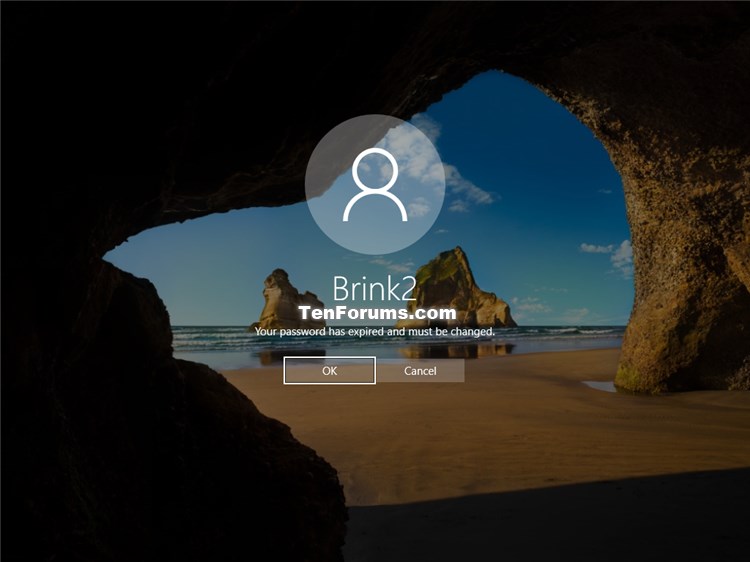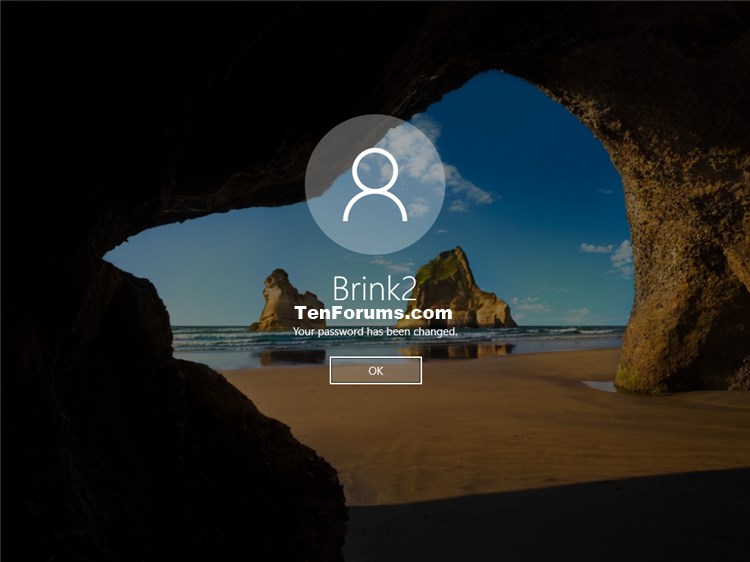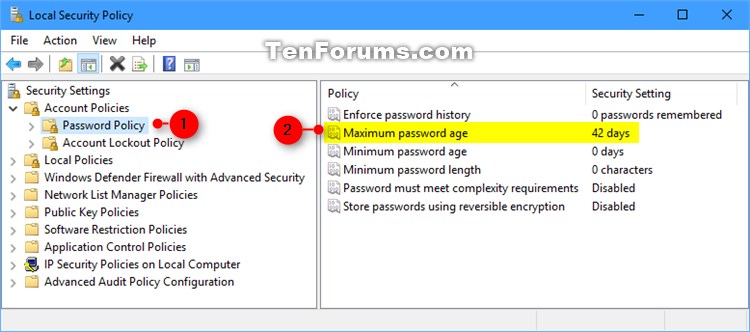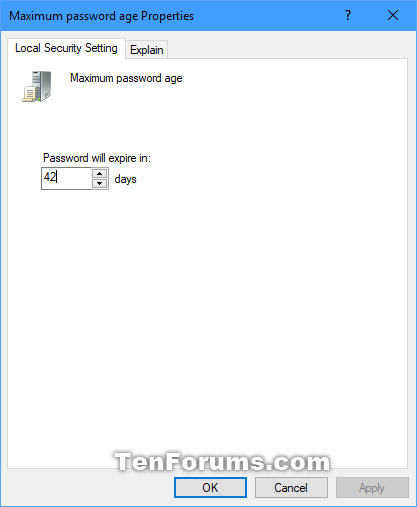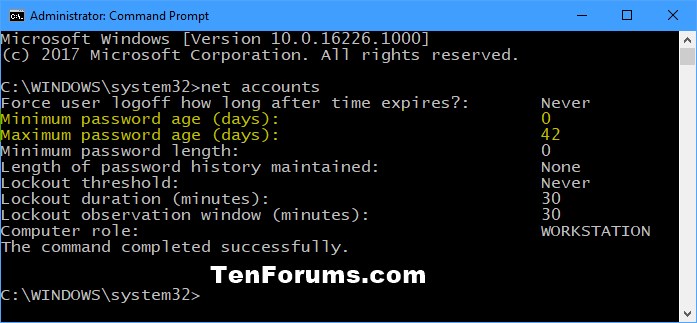How to Change Maximum and Minimum Password Age for Local Accounts in Windows 10
Information
Password expiration is a feature in Windows that forces a local account on the PC to change their passwords when a specified maximum (42 days by default) and minimum ( 0 days by default) password age has been reached.
The Maximum password age policy setting determines the period of time (in days) that a password can be used before the system requires the user to change it. You can set passwords to expire after a number of days between 1 and 999, or you can specify that passwords never expire by setting the number of days to 0. If Maximum password age is between 1 and 999 days, the minimum password age must be less than the maximum password age. If Maximum password age is set to 0, Minimum password age can be any value between 0 and 998 days.
The Minimum password age policy setting determines the period of time (in days) that a password must be used before the user can change it. You can set a value between 1 and 998 days, or you can allow password changes immediately by setting the number of days to 0. The minimum password age must be less than the Maximum password age, unless the maximum password age is set to 0, indicating that passwords will never expire. If the maximum password age is set to 0, the minimum password age can be set to any value between 0 and 998.
This tutorial will show you how to change the maximum and minimum password age for local accounts in Windows 10.
You must be signed in as an administrator to change the maximum and minimum password age.
Warning
You must have password expiration enabled for a local account to have the set maximum and minimum password age enforced.
CONTENTS:
- Option One: To Change Maximum Password Age for Local Accounts using Local Security Policy
- Option Two: To Change Minimum Password Age for Local Accounts using Local Security Policy
- Option Three: To Change Maximum Password Age for Local Accounts using Command Prompt
- Option Four: To Change Minimum Password Age for Local Accounts using Command Prompt
EXAMPLE: "Your password has expired and must be changed" at sign-in
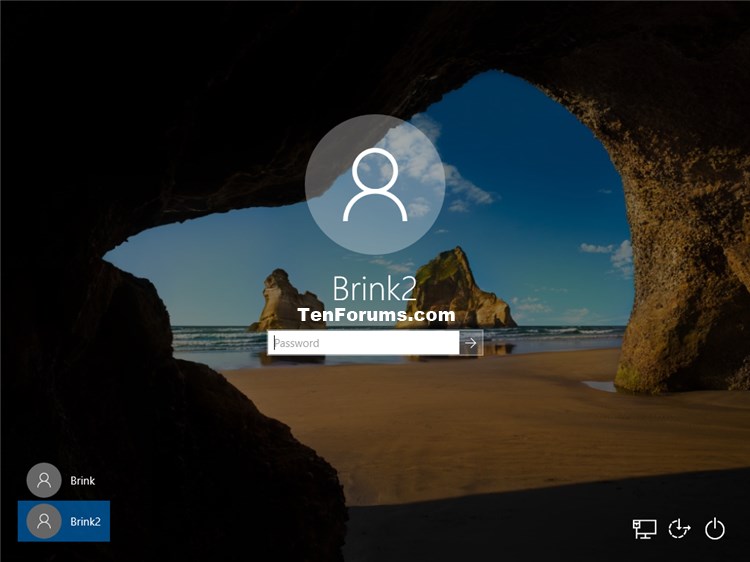

Note
Local Security Policy is only available in the Windows 10 Pro, Enterprise, and Education editions.
All editions can use Option Three below.
1. Press the Win+R keys to open Run, type secpol.msc into Run, and click/tap on OK to open Local Security Policy.
2. Navigate to Account Policies and Password Policy in the left pane of Local Security Policy. (see screenshot below)
3. In the right pane of Password Policy, double click/tap on the Maximum password age policy. (see screenshot above)
4. Type in a number between 0 and 999 for how many days you want a password can be used before it expires, and click/tap on OK. (see screenshot below)
Note
The default setting is 42 days.
You can specify that passwords never expire by setting the number of days to 0.
The minimum password age must be less than the maximum password age.
5. When finished, you can close the Local Security Policy window if you like.
6. If you like, you can force local accounts to change their password at next sign-in to enforce your changes to minimum and maximum password age.
Note
Local Security Policy is only available in the Windows 10 Pro, Enterprise, and Education editions.
All editions can use Option Four below.
1. Press the Win+R keys to open Run, type secpol.msc into Run, and click/tap on OK to open Local Security Policy.
2. Navigate to Account Policies and Password Policy in the left pane of Local Security Policy. (see screenshot below)
3. In the right pane of Password Policy, double click/tap on the Minimum password age policy. (see screenshot above)
4. Type in a number between 0 and 998 for how many days you want a password can be changed after, and click/tap on OK. (see screenshot below)
Note
The default setting is 0 days.
The minimum password age must be less than the maximum password age.
5. When finished, you can close the Local Security Policy window if you like.
6. If you like, you can force local accounts to change their password at next sign-in to enforce your changes to minimum and maximum password age.
1. Open an elevated command prompt.
2. Enter the command below into the elevated command prompt, press Enter, and make note of the current maximum and minimum password age. (see screenshot below)

net accounts
3. Enter the command below into the elevated command prompt, and press Enter. (see screenshot below)

net accounts /maxpwage:days
Note
Substitute days in the command above with a number between 1 and 999 for how many days you want a password can be used before it expires.
The default setting is 42 days.
The minimum password age must be less than the maximum password age.
4. When finished, you can close the elevated command prompt if you like.
5. If you like, you can force local accounts to change their password at next sign-in to enforce your changes to minimum and maximum password age.
1. Open an elevated command prompt.
2. Enter the command below into the elevated command prompt, press Enter, and make note of the current maximum and minimum password age. (see screenshot below)

net accounts
3. Enter the command below into the elevated command prompt, and press Enter. (see screenshot below)

net accounts /minpwage:days
Note
Substitute days in the command above with a number between 1 and 998 for how many days you want a password can be changed after.
The default setting is 0 days.
The minimum password age must be less than the maximum password age.
4. When finished, you can close the elevated command prompt if you like.
5. If you like, you can force local accounts to change their password at next sign-in to enforce your changes to minimum and maximum password age.
That's it,
Shawn Brink
Related Tutorials
- How to Enforce Password History for Local Accounts in Windows 10
- How to Enable or Disable Password Expiration for Local Accounts in Windows 10
- How to Add Password to Local Account in Windows 10
- How to Allow or Prevent User to Change Password in Windows 10
- How to Change Password of Local Account or Microsoft Account in Windows 10
- How to Change Minimum Password Length for Local Accounts in Windows 10
- How to Force Local Account to Change Password at Next Sign-in in Windows 10
- How to Reset Password of Local Account or Microsoft Account in Windows 10
- How to Remove Password of Local Account in Windows 10
- How to Change Account Lockout Threshold for Local Accounts in Windows 10
- How to Change Account Lockout Duration for Local Accounts in Windows 10
- How to Change Reset Account Lockout Counter for Local Accounts in Windows 10
- How to Remove Change a Password from Ctrl+Alt+Del Screen in Windows
Change Maximum & Minimum Password Age for Local Accounts in Windows 10

Change Maximum & Minimum Password Age for Local Accounts in Windows 10
How to Change Maximum and Minimum Password Age for Local Accounts in Windows 10Published by Shawn BrinkCategory: User Accounts
07 Apr 2024
Tutorial Categories


Related Discussions


